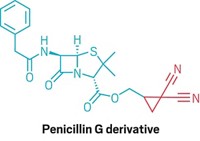Advertisement
Grab your lab coat. Let's get started
Welcome!
Welcome!
Create an account below to get 6 C&EN articles per month, receive newsletters and more - all free.
It seems this is your first time logging in online. Please enter the following information to continue.
As an ACS member you automatically get access to this site. All we need is few more details to create your reading experience.
Not you? Sign in with a different account.
Not you? Sign in with a different account.
ERROR 1
ERROR 1
ERROR 2
ERROR 2
ERROR 2
ERROR 2
ERROR 2
Password and Confirm password must match.
If you have an ACS member number, please enter it here so we can link this account to your membership. (optional)
ERROR 2
ACS values your privacy. By submitting your information, you are gaining access to C&EN and subscribing to our weekly newsletter. We use the information you provide to make your reading experience better, and we will never sell your data to third party members.
Synthesis
One-two punch converts benzenes to cyclohexenes
Tweaks to tungsten-benzene complex enable a tandem addition reaction for making drug intermediates
by Stephen K. Ritter
August 28, 2017
| A version of this story appeared in
Volume 95, Issue 34

Aromatic compounds are largely untapped as precursors for synthesizing cyclohexadienes and cyclohexenes, typically because of the harsh conditions needed to overcome the stability of the delocalized ring. But Katy B. Wilson has developed a tungsten-mediated reaction system that makes this dearomatization seem easy. Working in W. Dean Harman’s research group at the University of Virginia, Wilson has found that including a trifluoromethyl group on the benzene ligand of a tungsten complex, [trispyrazolylborate]W(NO)[P(CH3)3](η2-benzene), enhances the metal-arene interaction and exerts control over the sequential protonation and attack of two nucleophilic reagents on the aromatic ligand. The result, as Wilson described at the ACS national meeting, is a new tandem addition reaction for preparing highly functionalized trifluoromethylated cyclohexenes with regio- and stereocontrol, such as the example shown (J. Am. Chem. Soc. 2017, DOI: 10.1021/jacs.7b05118). Harman’s group has a history of using this type of metal complex to induce unexpected reactivity in aryl molecules, including dearomatization of aromatic and heteroaromatic rings and enabling pyridines to undergo Diels-Alder reactions. Dearomatizations are often a key step in building the core structures of natural products and other bioactive compounds. Wilson said the team isn’t out to synthesize natural products but is looking for reactions useful in midstage functionalizations during the optimization of drug leads.




Join the conversation
Contact the reporter
Submit a Letter to the Editor for publication
Engage with us on Twitter